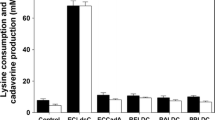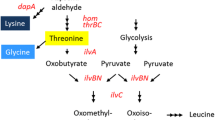Summary
A new process (Living Cell Reaction Process) forl-isoleucine production using viable, non-growing cells ofBrevibacterium flavum AB-07 was optimised using ethanol as the energy source and α-ketobutyric acid (α-KB) as precursor.l-valine also could be produced from glucose at high yield by this process. This process differs from the usual fermentation method in that non-growing cells are used, and the production ofl-isoleucine andl-valine were carried out under conditions of repressed cell division and growth. Minimal medium missing the essential growth factor, biotin was employed as the reaction mixture for the production ofl-isoleucine andl-valine. The productivity ofl-isoleucine andl-valine were 200 mmol·l−1 · day−1 (molecular yield to α-KB: 95%) and 300 mmol · l−1 · day−1 (molecular yield to glucose: 80%) respectively. The content ofl-isoleucine andl-valine in total amino acids produced in the each mixture were 97% and 96% respectively.
Similar content being viewed by others
References
Kisumi, M., J. Kato, S. Komatsubara and I. Chibata 1971. Increase in isoleucine accumulation by α-aminobutyric acid-resistant mutants ofSerratia marcescens. Appl. Microbiol. 21: 569–574.
Kisumi, M., S. Komatsubara, M. Sugiura and I. Chibata. 1971. Properties of isoleucine hydroxamate-resistant mutants ofSerratia marcescens. J. Gen. Microbiol. 69: 291–297.
Shiio, I., A. Sasaki, S. Nakamori and K. Sano. 1973. Production ofl-isoleucine by AHV resistant mutants ofBrevibacterium flavum. Agr. Biol. Chem. 37: 2053–2061.
Ikeda, S., I. Fujita and F. Yoshinaga. 1976. Screening ofl-isoleucine producers among ethionine resistant mutants ofl-threonine producing bacteria. Agr. Biol. Chem. 40: 511–516.
Yukawa, H. and M. Terasawa. 1986.l-Isoleucine production by ethanol utilizing micro-organism. Process Biochem. 21: 196–199.
Kisumi, M., S. Komatsubara and I. Chibata. 1973. Leucine accumulation by isoleucine revertants ofSeratia marcescens resistant to α-aminobutyric acid: lack of both feedback inhibition and repression. J. Biochem. 73: 107–115.
Tsuchida, T., F. Yoshinaga, K. Kubota and H. Momose. 1975. Production ofl-valine by 2-thiazolealanine resistant mutants derived from glutamic acid producing bacteria. Agr. Biol. Chem. 39: 1319–1322.
Kisumi, M., S. Komatsubara and I. Chibata. 1971. Multivalent repression and genetic derepression of isoleucine-valine biosynthetic enzymes inSerratia marcescens. J. Bacteriol. 107: 824–827.
Kisumi, M., S. Komatsubara and I. Chibata. 1971. Valine accumulation by α-aminobutyric acid-resistant mutants ofSerratia marcescens. J. Bacteriol. 106: 493–499.
Seiler, N. 1983. Liquid chromatographic methods for assaying polyamines using prechromatographic derivatization. Methods Enzymol. 94: 10–36.
Author information
Authors and Affiliations
Rights and permissions
About this article
Cite this article
Terasawa, M., Inui, M., Goto, M. et al. Living cell reaction process forl-isoleucine andl-valine production. Journal of Industrial Microbiology 5, 289–293 (1990). https://doi.org/10.1007/BF01578203
Received:
Revised:
Accepted:
Issue Date:
DOI: https://doi.org/10.1007/BF01578203




